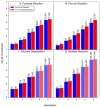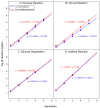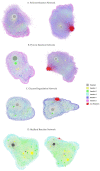The Effects of Iron on In Silico Simulated Abiotic Reaction Networks
- PMID: 36558002
- PMCID: PMC9787479
- DOI: 10.3390/molecules27248870
The Effects of Iron on In Silico Simulated Abiotic Reaction Networks
Abstract
Iron is one of the most abundant elements in the Universe and Earth's surfaces, and undergoes a redox change of approximately 0.77 mV in changing between its +2 and +3 states. Many contemporary terrestrial organisms are deeply connected to inorganic geochemistry via exploitation of this redox change, and iron redox reactions and catalysis are known to cause significant changes in the course of complex abiotic reactions. These observations point to the question of whether iron may have steered prebiotic chemistry during the emergence of life. Using kinetically naive in silico reaction modeling we explored the potential effects of iron ions on complex reaction networks of prebiotic interest, namely the formose reaction, the complexifying degradation reaction of pyruvic acid in water, glucose degradation, and the Maillard reaction. We find that iron ions produce significant changes in the connectivity of various known diversity-generating reaction networks of proposed prebiotic significance, generally significantly diversifying novel molecular products by ~20%, but also adding the potential for kinetic effects that could allow iron to steer prebiotic chemistry in marked ways.
Keywords: Maillard reaction; chemical reaction networks; combinatorial chemistry; formose reaction; glucose; iron chemistry; iron-sulfur world; origins of life; prebiotic chemistry; pyruvic acid.
Conflict of interest statement
The authors declare no conflict of interest.
Figures









Similar articles
-
Plausibility of the Formose Reaction in Alkaline Hydrothermal Vent Environments.Orig Life Evol Biosph. 2023 Jun;53(1-2):113-125. doi: 10.1007/s11084-020-09599-5. Epub 2020 Sep 15. Orig Life Evol Biosph. 2023. PMID: 32749559
-
FeS/S/FeS(2) redox system and its oxidoreductase-like chemistry in the iron-sulfur world.Astrobiology. 2011 Jun;11(5):471-6. doi: 10.1089/ast.2011.0624. Astrobiology. 2011. PMID: 21707387
-
From Catalysis of Evolution to Evolution of Catalysis.Acc Chem Res. 2024 Nov 5;57(21):3081-3092. doi: 10.1021/acs.accounts.4c00196. Epub 2024 Oct 7. Acc Chem Res. 2024. PMID: 39373892 Free PMC article.
-
On the Use of Iron in Organic Chemistry.Molecules. 2020 Mar 16;25(6):1349. doi: 10.3390/molecules25061349. Molecules. 2020. PMID: 32188092 Free PMC article. Review.
-
Biogeochemistry of dihydrogen (H2).Met Ions Biol Syst. 2005;43:9-48. doi: 10.1201/9780824751999.ch2. Met Ions Biol Syst. 2005. PMID: 16370113 Review.
Cited by
-
The second wave of formose research.BBA Adv. 2025 Jan 17;7:100141. doi: 10.1016/j.bbadva.2025.100141. eCollection 2025. BBA Adv. 2025. PMID: 39974666 Free PMC article.
References
-
- Dhungana S., Crumbliss A.L. Coordination Chemistry and Redox Processes in Siderophore-Mediated Iron Transport. Geomicrobiol. J. 2005;22:87–98. doi: 10.1080/01490450590945870. - DOI
MeSH terms
Substances
LinkOut - more resources
Full Text Sources
Medical

